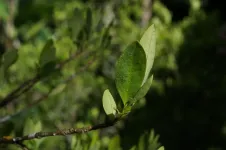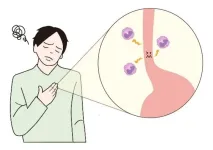(Press-News.org) Cutting farm nitrous oxide emissions helps climate and ozone layer
Adding crushed basalt rocks and special fertilisers can reduce potent nitrous oxide (N2O) greenhouse gas emissions and safeguard the stratospheric ozone layer, which protects us from harmful UV light and reduces nitrate leaching into water bodies protecting ecosystems and human health
The new study, led by researchers at the University of Sheffield, highlights methods for reducing N2O emissions, such as enhanced weathering of agricultural soils with crushed basalt, that offer a cost-free co-benefit for N2O mitigation with financial savings for farmers whilst helping them achieve climate goals
The findings emphasise the importance of N2O mitigation for sustainable agriculture, aligning with efforts to reach net-zero emissions and supporting increased food production for a growing population
Farming methods can reduce nitrous oxide emissions without slowing down the overall recovery of the ozone layer, results from new research have shown.
Nitrous oxide (N2O), a powerful greenhouse gas which is 300 times more potent than CO2, is building up in the atmosphere at an alarming rate. Agriculture contributes significantly to N2O emissions.
New research, conducted by the University of Sheffield, showed that using special fertilisers and crushed basalt rocks (enhanced rock weathering) has the potential to reduce agricultural emissions of N2O without harming the ozone (O3) layer.
There is an international focus on developing N2O reduction strategies to stop soil from releasing nitrous oxide into the air but there have been concerns that cutting these emissions might slow down the recovery of the ozone layer.
The research team, from the University of Sheffield’s Leverhulme Centre for Climate Change Mitigation, used a state-of-the-art earth system model to simulate the effects of reducing N2O emissions, using fertilisers with nitrification inhibitors and enhanced rock weathering, across two different climate scenarios, both following international agreements to protect the ozone layer.
The model allowed the research to take into account how other important gases (like CFCs) and future climate conditions affect the atmosphere. The scenarios differed in how much the Earth's temperature would rise. Reductions of N2O considered in the analysis represented a feasible planned strategy and demonstrated how this reduction strategy might impact the ozone layer under a variety of future conditions.
The study, published in the Nature Journal npj Climate and Atmospheric Science, is unique in that it bridges climate change mitigation and ozone layer protection, highlighting the dual benefits of N2O reduction strategies which can provide substantial climate benefits by cooling the planet from reducing N2O, protecting the O3 layer and hence not impacting harmful UV rays, and environmental benefits by reducing nitrate leaching into water bodies and natural habitats. This integration is important for developing comprehensive environmental policies.
The research was led by Dr Maria Val Martin and Dr David Beerling from the School of Biosciences and the Leverhulme Centre for Climate Change Mitigation at the University of Sheffield and conducted by Dr James Weber, former postdoctoral researcher at the University of Sheffield.
Dr Val Martin, UKRI Future Leaders Fellow at the University of Sheffield’s School of Biosciences and co-author of the study said: “The results showed that a feasible use of fertilisers with nitrification inhibitors and enhanced rock weathering could cut agricultural N2O emissions by about 25 per cent without hindering ozone recovery.
“This supports the alignment of agricultural practices with international climate and ozone protection policies, such as the Montreal Protocol and we hope this will influence policymakers to integrate N2O mitigation measures more robustly into climate action plans and potentially lead to new regulations and incentives for farmers to adopt these practices.”
The economic analysis from the study also showed cost-free co-benefits of enhanced weathering practices for N2O reduction.
Professor David J Beerling, Director of the Leverhulme Centre for Climate Change Mitigation and co-author of the study said: “The findings emphasise the importance of N2O mitigation for sustainable agriculture, aligning with efforts to reach net-zero emissions while still supporting increased food production for a growing population.
“The study has highlighted cost-effective methods for reducing N2O emissions, such as enhanced weathering of agricultural soils with crushed basalt. These practices offer financial savings for farmers and can reduce the overall cost of achieving climate goals, benefiting taxpayers and consumers.”
Overall, this research shows that reducing N2O emissions from farms is a safe and effective way to fight climate change while protecting the ozone layer. It is hoped that this will lead to new farming practices that are good for the planet and for people.
To read the full study, please visit: https://www.nature.com/articles/s41612-024-00678-2
ENDS
Notes to Editors:
For more information about research at the University of Sheffield’s School of Biosciences, please visit: https://www.sheffield.ac.uk/biosciences
Biosciences at Sheffield is rated 4th in the UK for the quality of research
For more information about the Leverhulme Centre for Climate Change Mitigation visit:
https://www.sheffield.ac.uk/lc3m
END
Cutting farm nitrous oxide emissions helps climate and ozone layer
2024-07-10
ELSE PRESS RELEASES FROM THIS DATE:
Blood cancer drug could make radiotherapy on brain tumours more effective
2024-07-10
Drugs developed to fight blood and other cancers could also help improve the efficiency of radiotherapy in the most commonly diagnosed low-grade brain tumour in adults, a new study has found.
Meningioma account for approximately 36% of all primary brain tumours. The majority are successfully treated by surgery, but some which can’t easily be accessed need to be treated with radiotherapy. That can cause significant side effects and radiation damage to the brain, while resistance to radiotherapy can also result in tumour growth.
A new study by researchers at the Brain Tumour Research ...
Does air pollution affect lupus risk?
2024-07-10
New research published in Arthritis & Rheumatology indicates that chronic exposure to air pollutants may increase the risk of developing lupus, an autoimmune disease that affects multiple organs.
For the study, investigators analyzed data on 459,815 participants from the UK Biobank. A total of 399 lupus cases were identified during a median follow-up of 11.77 years. Air pollutant exposure was linked with a greater likelihood of developing lupus. Individuals with a high genetic risk and high air pollution exposure had the highest risk of developing ...
Can certain bacteria or fungi combat a plant pathogen that attacks common vetch?
2024-07-10
Anthracnose, a severe disease caused by the Colletotrichum spinaciae plant pathogen, often occurs in common vetch, a widely grown legume. Chemicals are not recommended for disease management because the plants are used as livestock feed. A new study published in Grassland Research reveals that treating common vetch with certain bacteria or fungi that promote plant growth may be effective for combating anthracnose.
Treating common vetch with these bacteria or fungi increased the activity of plant defense enzymes and promoted the presence of healthy bacteria that could keep Colletotrichum spinaciae at bay.
“The combined use of plant growth‐promoting rhizobacteria such as Bacillus ...
Can omega-3 fatty acid intake affect acne severity?
2024-07-10
In a study in the Journal of Cosmetic Dermatology that included 60 individuals with mild to moderate acne, following the Mediterranean diet and taking omega-3 fatty acid supplements led to significant reductions in inflammatory and non-inflammatory skin lesions, as well as improved quality of life.
Notably, 98.3% of participants had omega-3 fatty acid deficits at the start of the study. Acne severity lessened significantly in those who reached target omega-3 fatty acid levels during the study.
“Lifestyle interventions, including dietary recommendations, should ...
How did surge facilities impact the time to reunification for unaccompanied migrant children and their families?
2024-07-10
Unaccompanied children entering the United States without adult legal guardians and legal status account for a growing share of U.S. Border Patrol encounters along the southern border, with most fleeing extreme violence, poverty, and food insecurity. In response, emergency intake sites and influx care facilities (surge facilities) were used to promptly house unaccompanied children. A new analysis published in Economic Inquiry finds that the emergency shelters expedited the reunification of children with their families.
By analyzing data on unaccompanied minors encountered ...
Could new discovery help treat a rare and severe form of amyloidosis?
2024-07-10
In people with a rare condition called light chain amyloidosis, light chain proteins—which are a component of antibodies—mutate and build up in different organs. In new research published in The FEBS Journal, investigators have identified and characterized an antibody fragment that can bind to abnormal light chains to stabilize them and prevent their aggregation.
The findings could have an important clinical impact because the current prognosis for individuals with light chain amyloidosis is extremely poor, and current treatments, ...
We can’t distinguish wild coca plants from those grown to make cocaine
2024-07-10
A new paper in Molecular Biology and Evolution, published by Oxford University Press, indicates that while the United Nations Office on Drugs and Crime has collected annual data on areas of coca cultivation in South America for decades – to monitor the establishment of illegal plantations and associated deforestation – scientists can’t reliably distinguish between different types of coca plants. While identification often relies on leaf shape and size, this does not reflect differences between coca varieties grown for extracting the alkaloid cocaine (the active ingredient in the recreational drug), coca cultivated for traditional purposes, ...
Chronic allergic disorder EoE’s rising incidence in Japan confirmed by large-scale data analysis
2024-07-10
Osaka, Japan — In one of the first studies of its kind in Japan, Osaka Metropolitan University-led researchers uncovered the incidence and prevalence of the chronic allergic disorder eosinophilic esophagitis, or EoE.
EoE can cause difficulty in swallowing with tissue inflammation and fibrosis as eosinophils, a type of white blood cell, build up in the esophagus. EoE cases have been increasing in North America and Western Europe since the 1990s, but little has been known about the situation in Asia including Japan.
Dr. Akinari Sawada, Associate Professor Fumio Tanaka, and Professor Yasuhiro Fujiwara of OMU’s Graduate School of Medicine and colleagues analyzed a ...
Does living in America’s wealthiest communities make you safer?
2024-07-10
HERNDON, Va., July 10, 2024 -- One of the privileges the wealthiest Americans enjoy is living wherever they want. But new research published in Risk Analysis suggests they should be cautious when choosing their Shangri-La.
In their nationwide analysis, Rutgers University geographers Michael Greenberg and Dona Schneider compared the concentration of hazards and associated risks impacting the richest and poorest counties and the richest and poorest municipalities in all 50 states (200 locations).
When ...
Spectacular auroras are caused by head-on blows to Earth’s magnetic field that could damage critical infrastructure
2024-07-10
Auroras have inspired myths and portents for millennia — but only now, with modern technology dependent on electricity, are we appreciating their true power. The same forces which cause auroras also cause currents that can damage infrastructure which conducts electricity, like pipelines. Now scientists writing in Frontiers in Astronomy and Space Sciences have demonstrated that the impact angle of interplanetary shocks is key to the currents’ strength, offering an opportunity to forecast dangerous shocks and shield critical infrastructure.
“Auroras and geomagnetically induced currents are ...


